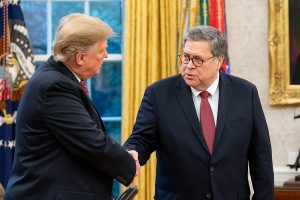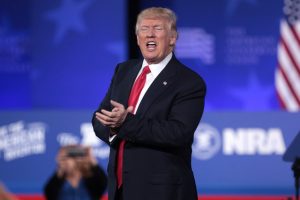by John Feffer
During a lifetime of make-believe, Donald Trump has never pretended to be a conventional politician. When he finally decided to make a serious bid for office, he built his presidential aspirations on the flimsiest of foundations: a wild conspiracy theory about Barack Obama’s birthplace. His leadership bona fides were equally laughable, having presided over bankrupt casinos and failed real-estate projects, fabricated the persona of a lady-killer, and created a reality TV show about a tin-pot entrepreneur.
It wasn’t difficult to predict how all this would end up politically. Plenty of oddballs had run for president, from Jello Biafra to Roseanne Barr, and gotten nowhere. The guardrails of American democracy were set up to prevent just such outsiders from making it anywhere near the Oval Office. Donald Trump’s three presidential qualifications — money, name recognition, and unbounded arrogance — were obviously not enough to overcome his lack of sway with party bosses. Seasoned politicians and backroom operators, the putative “adults in the room,” had spent years ridiculing the blowhard with the bad hair banging on the door and demanding red-carpet treatment.
And then, of course, he won. In the 2016 presidential election, the guardrails of democracy collapsed. The Electoral College, designed to weed out all those with what Alexander Hamilton had once called “talents for low intrigue and the little arts of popularity,” delivered a victory to a candidate who had talents for little else. As Jeff Greenfield wrote at Politico immediately after the elections,
“The blunt fact is that many of the guardrails that were supposed to protect the world’s oldest functioning democracy have been shown to be perilously weak, as vulnerable to assault as the Maginot Line was in the face of the German army some 75 years ago.”
In the wake of The Donald’s upset victory, journalists and pundits hastened to recommend a slate of advisers who could inject some gravitas into the new administration and restore an approximation of that Maginot Line. Under counsel from such grey eminences as former national security advisors Henry Kissinger and Condoleezza Rice, the new president brought a bevy of such “adults” into his administration, including ExxonMobil oil executive Rex Tillerson as secretary of state and active duty Lieutenant General H.R. McMaster as national security advisor. Two “adults,” Republican Party grandee Reince Priebus and retired Marine Corps General John Kelly, have similarly tried, as White House chiefs of staff, to manage Trump. Recently, a New York Times op-ed written by an anonymous “senior administration official” suggested that a “steady state” of “adults in the room” has been covertly ensuring that President Trump doesn’t blow up the country or the world.
In response, President Trump has done his best to fire or at least ignore all such adult supervisors. After the departures of Tillerson, McMaster, and economic adviser Gary Cohn, the New Republic lamented that Trump was “systematically removing the guardrails in his cabinet” (which proved no more effective than the electoral ones). In fact, after the latest “crazytown” revelations in the bestselling new book by veteran Washington Post journalist Bob Woodward, perhaps it’s time to retire those creaky metaphors of American politics. No more “guardrails,” no more “adults.” They represent thinking that has proven woefully inadequate for understanding Donald Trump’s rise to power or the America of this moment.
Forget Donald Trump for a second and just think to yourself: Who’s responsible for the last 17 years of never-ending American wars that have convulsed the planet? Babies? Teenagers? Grown men acting like babies? Let’s face it: perfectly sober adults, including the man who left ExxonMobil to become secretary of state, have long seemed intent on ensuring the flooding, burning, and general destruction of this planet. And don’t forget that the adults in the Republican Party, backed by their deep-pocket funders, were responsible for getting Donald Trump over the hump and into the Oval Office. Ultimately they, and not the policy-ignorant president, are to blame for the devastation that followed.
As for those guardrails, they represent, at best, the most imperfect of metaphors. Despite all the actual guardrails on American highways, traffic fatalities have risen to more than 40,000 a year and cars are now the top killers of Americans between the ages of 15 and 24. Guardrails may prevent the occasional drunk from driving into a ravine, but they obviously don’t stop a significant portion of the population from committing autocide.
The truth is: those guardrails of democracy were faulty long before Trump came along and some of the adults in the room are scarier than the squalling infant. Such metaphors, in fact, make it increasingly difficult to see what Trump and his babysitters are really doing: not just destroying a culture of civility or undoing the accomplishments of the Obama administration but attacking the very pillars of democracy.
Moving the Guardrails
Donald Trump, The Washington Post concluded a year after his election, had broken through “the guardrails of presidential behavior.”
Given the sheer number of lies he’s spewed in his tenure in office — more than eight mistruths a day and rising — the Post’s conclusion seems incontrovertible. However, when it comes to wrongdoing, Trump has plenty of presidential precedents, from the high crimes and misdemeanors of Richard Nixon to the torture policies of George W. Bush. Trump is as crude as Lyndon Baines Johnson, as ill prepared as Ronald Reagan, as sexually predatory as Bill Clinton. All of these presidents prepared the American public for a leader who, like some super villain in a comic strip, would combine the worst qualities of his predecessors in one explosive package.
Trump broke through no guardrails (a feature of highway safety that he once disparaged in a Wall Street Journal interview as the “worst crap”). Rather, generations of politicians and operatives incrementally moved them to such a degree that his behavior became acceptable to enough Americans to elect him.
Admittedly, his actions are now breaking new ground. He’s elevated family members — daughter Ivanka and son-in-law Jared Kushner — to senior policy positions, while ensuring that his business empire profits from his presidency in unprecedented ways. Still, to understand the more lasting impact of the Trump administration requires a look at how his crew is transforming the underlying structures of American democracy, whether it’s the influence of money on politics, the hijacking of the judiciary, or the undermining of media watchdogs.
Trump grabs the daily headlines with his loose tweets and outrageous acts. The savvy operators and implementers lurking in his shadow use the cover of scandal to move those guardrails in a big league fashion. The defenders of today’s Maginot Line will wake up some morning to discover that the enemy never had to storm the battlements. They just uprooted the fortifications and shoved them out of the way.
Boosting the Rich
Many democratic countries wouldn’t tolerate the way the rich and corporations call the shots in American elections. To win a House seat, for example, now costs, on average, $1.5 million; a Senate seat, nearly $20 million. By contrast, in Canada, where neither corporations nor unions can make campaign contributions and individuals are restricted to a very modest $1,500 cap on party donations, a typical campaign for parliament costs in the tens of thousands of dollars and nearly half of the biggest spenders lose.
In 2010, the situation in the United States became incomparably worse when the Supreme Court decided, in the Citizens United case, that campaign contributions are constitutionally protected free speech. Super PACs can now spend unlimited amounts of money on elections, giving rich individuals unparalleled impact and a way to cover their tracks through “dark money” contributions. Former president Jimmy Carter has accurately labeled that decision “legalized bribery.”
Meanwhile, money has come to play a remarkable role in policymaking, too. Where other countries struggle to expunge bribery and corruption from their political systems, the United States has simply institutionalized it under the rubric of lobbying. As Michael Maiello wrote in Forbes back in 2009:
“[I]n an open society like the U.S., our brightest minds are unable to draw meaningful distinctions between handing someone an envelope full of cash and flooding a senator’s campaign war chest, except to point out that lobbying is far more effective. A briber wants to circumvent the law. A lobbyist wants to change it.”
Trump famously declared his independence from donors and lobbyists. He told the Koch brothers, for instance, that he didn’t “need their money or bad ideas.” In the end, however, he would prove just as beholden to big donors as any conventional politician. He rode to power with the backing of casino magnate Sheldon Adelson, Home Depot co-founder Bernard Marcus, World Wrestling Entertainment co-founder Linda McMahon, hedge fund operator Robert Mercer, and philanthropist Betsy DeVos. After the election, he immediately rewarded McMahon and DeVos with administration positions, then pushed through a tax reform bill that was a bonanza for his billionaire buddies and transformed Middle East policy to reflect the demands of Adelson, Marcus, and Mercer. And though he promised to clean out the Washington swamp, his appointees have been embroiled in one scandal after another.
The Trump team is also making structural changes to restrict the ways that ordinary citizens can, in the future, challenge such a plutocratic form of government. Building on successful Republican Party efforts in, for instance, Florida leading up to the 2000 presidential election, the Trump administration is going all out to suppress the electoral participation of minorities and the poor. New voter ID laws helped him win key states like Wisconsin, so no surprise that he wants to make such a voter ID system a nationwide one.
Leading up to the midterms, the Republican Party has also been rushing to purge voter rolls and put in place racial gerrymandering, even using the Americans with Disabilities Act as an excuse to close polling places in rural Georgia to tamp down the African-American vote. In a team effort by the Justice Department and Immigration and Customs Enforcement, the president has also directed federal agencies to gather voting records in areas of North Carolina with large Latino populations in order to keep likely Democratic Party voters away from the polls.
In this way, Trump is working to return America to its glory days — when only well-off white men had the right to vote.
Tilting the Courts
Trump controls (if that’s the term for it) the White House; the Republicans, in part through voter suppression and gerrymandering, control Congress. But pollsters predict that the Democrats are likely to win back at least the House in the coming midterm elections and the 2020 presidential election is clearly still up for grabs. So, in its quest to move the political guardrails more permanently, the Trump administration has focused on the third branch of government: the courts. There, it can not only neuter one of the most powerful checks on Trump’s 1% agenda, but have an impact that will last for decades.
 With the Supreme Court, the Republicans in Congress proved both lucky and strategic. President Trump was immediately able to fill a vacancy, thanks to the Republican Party’s successful Hail Mary decision to block Merrick Garland’s nomination in the waning months of the Obama administration. Then, by nominating Neil Gorsuch to fill the vacancy created by Antonin Scalia’s death, the Trump team began to make a play for the retirement of swing-voting justice Anthony Kennedy. Gorsuch had clerked for Kennedy and so had the two key candidates (Brett Kavanaugh and Raymond Kethledge) that Trump fingered for his seat, should it become vacant. The president then played up his business relationship with Kennedy’s banker son, while Ivanka worked her charms on the judge over lunch. Administration officials swore that they would honor Kennedy’s legacy, as long as he resigned quickly enough to squeeze in another confirmation before those midterms threatened Republican majorities in Congress.
With the Supreme Court, the Republicans in Congress proved both lucky and strategic. President Trump was immediately able to fill a vacancy, thanks to the Republican Party’s successful Hail Mary decision to block Merrick Garland’s nomination in the waning months of the Obama administration. Then, by nominating Neil Gorsuch to fill the vacancy created by Antonin Scalia’s death, the Trump team began to make a play for the retirement of swing-voting justice Anthony Kennedy. Gorsuch had clerked for Kennedy and so had the two key candidates (Brett Kavanaugh and Raymond Kethledge) that Trump fingered for his seat, should it become vacant. The president then played up his business relationship with Kennedy’s banker son, while Ivanka worked her charms on the judge over lunch. Administration officials swore that they would honor Kennedy’s legacy, as long as he resigned quickly enough to squeeze in another confirmation before those midterms threatened Republican majorities in Congress.
Meanwhile, the Trump team barreled along making judicial appointments to the lower courts at a time when it could barely be bothered to fill key positions in the State Department. The new president came into office with 105 unfilled judicial vacancies, a legacy of Republican congressional foot-dragging during the Obama years. While conservative allies supplied himwith a wish list of judicial ideologues, Trump acted with all deliberate haste by appointing 22 appeals court judges and 20 district judges (all lifetime positions). These new judges — in the 12 federal judicial circuits with regional jurisdiction — have already made their mark in cases involving campaign finance, presidential authority, and abortion, among other issues. “After just 18 months, Trump has ‘flipped’ two circuits — the Sixth and Seventh — from what Trump’s supporters in the conservative legal movement consider ‘liberal’ to more properly conservative,” writes Jason Zengerle in the New York Times Magazine, pointing out that other circuits are also now nearing the tipping point.
This judicial transformation extends to federal agencies. Administrative law judges are basically civil servants who handle a varied caseload from Social Security benefit claims to regulatory enforcement. After making a broad interpretation of a recent Supreme Court decision, the Trump administration is now transforming these 1,900 judges into the equivalent of political appointees. It also argues that it can fire judges and hire new ones to packsuch administrative courts, which will then help push a Republican anti-regulatory revolution from within.
At one point, Donald Trump casually remarked that he thought the United States should try out the Chinese system of “president for life.” While that’s not likely to happen any time soon, with his judges for life, the president is institutionalizing the 1% ideology of the adults in that room of his before the voters can kick him out of office.
Sidestepping the Watchdogs
After a lifetime using the media to build his brand, Donald Trump is now systematically trying to blow up one of the cornerstones of American democracy. He has called the press the “enemy of the American people,” repeatedly labeled reputable media outlets as “fake news,” and legitimized far-right sources by parroting their claims.
Trump didn’t create such a climate. The rise of Fox News, the spread of websites like Infowars, and the persistent popularity of right-wing radio shock jocks have all contributed to the demonization of the “liberal” media. As a result, for a significant number of Americans, trying to gather facts — as opposed to expressing opinions at top volume — has become a suspect occupation. According to the 2018 Edelman Trust Barometer, when it comes to the general population, trust in the media has dropped five points since 2017 and an astounding 22 points for the “informed public” (defined as college-educated and in the top 25% of household income).
The mainstream media have long aspired to serve a watchdog role. Reporters are supposed to fact-check the powerful, sniff out corruption, and peel away government propaganda to expose the hidden histories behind it. Granted, journalists have blind spots and the economically powerful often don’t receive the sort of scrutiny that the politically powerful do, but media operations with budgets for investigative journalists and fact-checkers are an integral part of any democratic society.
Donald Trump hasn’t just disparaged the mainstream media, he’s done an end run around it. He feels little need to hold press conferences — only one in his first year of office (compared to Obama’s 11) — because he communicates with the America he wants to reach directly through his Twitter account. The news media then have to play catch-up reporting on his tweets.
In doing so, he creates the appearance of candor, since he speaks his mind without PR specialists getting in the way — but not to the entire American population. Typically, he avoids making speeches in blue states (places that his administration’s policies are deliberately crafted to harm). His strategy is to preach to the choir 24/7 in a communications universe free of the mainstream media. When it comes to reporters, the president’s supporters follow his lead and pay them little attention. Indeed, 72% of Republicans trust Trump over the media and nearly half believe that “the president should have the authority to close news outlets engaged in bad behavior.” His attackson the media, deliberately designed to distract attention from his various scandals, are undermining the entire institution.
In effect, Trump has cultivated a constituency that lies outside the democratic conversation, building on the 22% of Americans who believe autocracy to be superior to democracy and the slightly larger percentage who would support a military coup to combat crime or corruption. Independent media wouldn’t last long in either scenario.
The New Normal
The most dangerous part of Trump’s onslaught on democracy is the cynicism it’s likely to generate, which will only reinforce the goals of the Trumpistas if a significant chunk of the 99% decide that voting isn’t worth it, politics is a game best avoided, and Twitter is superior to a newspaper. Democracy doesn’t just die in darkness. It can die of indifference — not with a bang or a whimper, that is, but with a yawn.
Of course, there’s nothing like a famously corrupt politician to reinvigorate civic action. In the aftermath of the Watergate scandals, a new wave of reformers won places in Congress, immediately launching investigations into covert operations, establishing new rules for campaign finance, and attempting to rein in the power of the presidency through measures like the War Powers Act. In other words, after the scandals of the early 1970s, reformers surveyed the wreckage of the political landscape and attempted to repair the infrastructure of American democracy. At best, they offered quick fixes, while during the Reagan years that followed, the putative adults in the room returned to their favorite activity: moving the guardrails to favor the wealthy and the powerful.
After the midterms in November, new voices like Alexandria Ocasio-Cortezand Rashida Tlaib will be in Congress and there will undoubtedly be renewed energy to stop, if not roll back, Trumpism. All those whom the president has insulted — and it’s an ever-lengthening list — may join hands in an effort to break the vicious circle of ignorance, apathy, and anger Trump has encouraged. This will be no easy task. But it would be poetic justice if what’s left of the mechanisms of democracy — voting, the courts, and the press — can still be used to defeat a potential autocrat, his family, and all the putative adults he’s brought into the room to implement his profoundly anti-democratic program. The question is: Will it already be too late?
Reprinted, with permission, from TomDispatch.






A shaking fact-based article. However, it might be late. The last change in Secretary of Defense may serve as a point of no-return to the project. A computer war-gamer would be chosen over any seasoned military.
I, as a non-USAan, get irritated by the tone of many articles on this subject, including this one, where the authors write as though American democracy were the be-all-and-end-all of democratic government. The current Kavanaugh shenanigans scream out loud that the USA lacks an independent judiciary (though that has been obvious since the November 2000 election of GW Bush and the notorious Citizens United ruling). Perhaps if Trump does enough damage, the USA will do what is really necessary now – draw up a new constitution. Other constitutional arrangements are available.
I must agree with John O, above. I am shocked by the pretence (see I am not an American!)that the USA even resembles a democracy. Long before Trump I noticed many indications that the USA behaves in its elections in ways no other “democracy” would consider eg choosing a POTUS when the selection of candidates cannot throw up anyone reasonable to represent the people. All the Congress reps are vetted by AIPAC, the seniority rules allow blatant bias in the introduction of laws, none of the laws passed serve the US people except the rich (Gilens and Page research 2014), all the courts are partisan and the divide between rich and poor is widening.